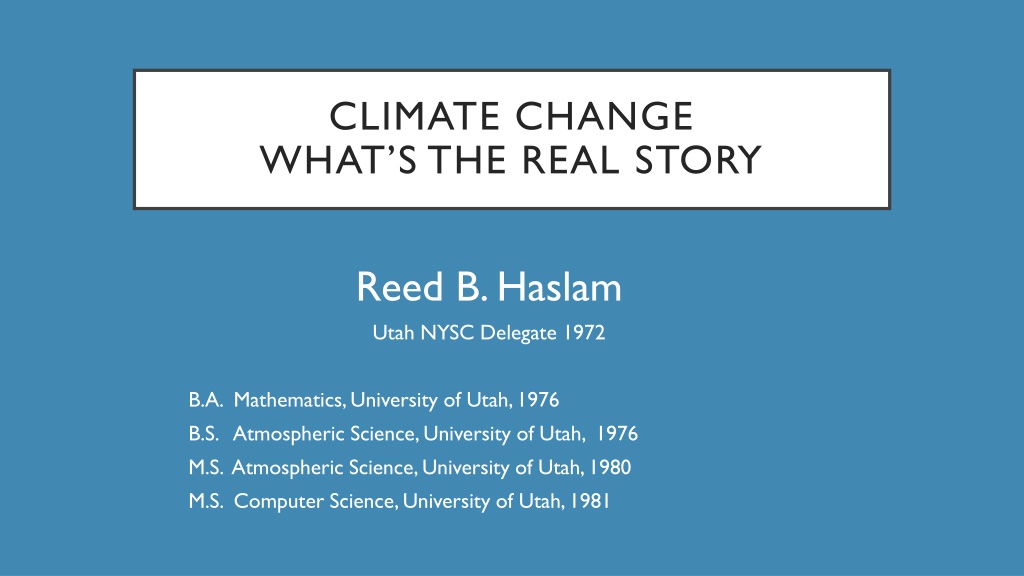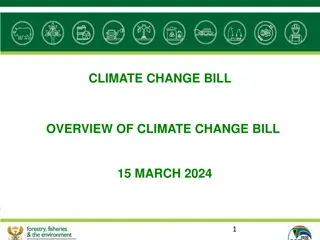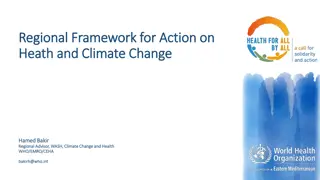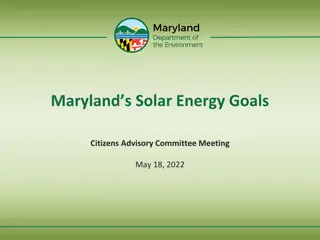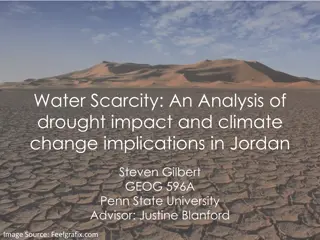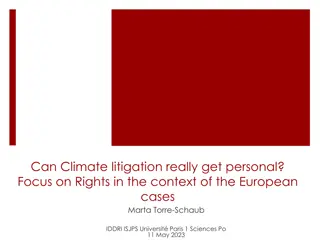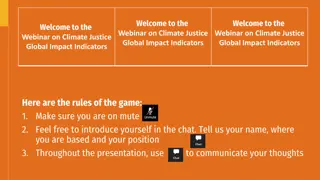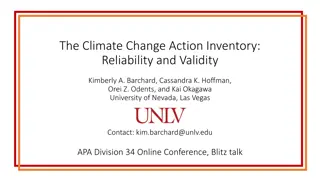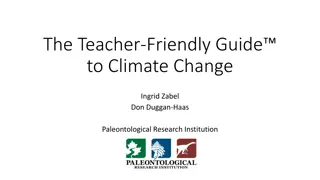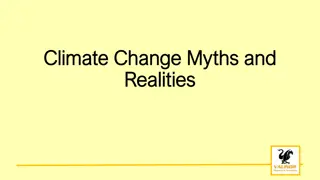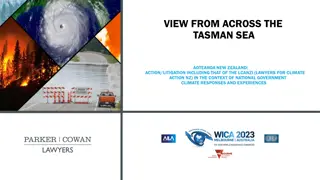Understanding Climate Change: Insights from Reed B. Haslam, NYSC Delegate 1972
Reed B. Haslam, an experienced atmospheric scientist, reflects on his early weather observations, noticing the impact of climate change through warming temperatures and reduced precipitation. He emphasizes the key contributors to global warming, such as deforestation and carbon dioxide emissions. Comparing Earth's CO2 levels to Venus, he highlights the critical role of CO2 in regulating temperatures. Imagine a world without CO2, where the tropics would be freezing. Learn more about the real story of climate change through Reed B. Haslam's observations and expertise in atmospheric science.
Download Presentation

Please find below an Image/Link to download the presentation.
The content on the website is provided AS IS for your information and personal use only. It may not be sold, licensed, or shared on other websites without obtaining consent from the author. Download presentation by click this link. If you encounter any issues during the download, it is possible that the publisher has removed the file from their server.
E N D
Presentation Transcript
CLIMATE CHANGE WHAT S THE REAL STORY Reed B. Haslam Utah NYSC Delegate 1972 B.A. Mathematics, University of Utah, 1976 B.S. Atmospheric Science, University of Utah, 1976 M.S. Atmospheric Science, University of Utah, 1980 M.S. Computer Science, University of Utah, 1981
NYSC 1972 In 1972 100 Young Men Attended 10thAnnual Camp in West Virginia. In Charleston we were housed for a couple of days by volunteer families. A dance was organized with young women from the Charleston area. The ride from there to Camp Pocahontas was by a military transport plane, as Hurricane Agnes was off the Atlantic Coast. It was a bit bumpy and the seats were just straps of fabric. IBM provided a computer at the camp. [The first PCs came in 1978]. I had my first experience programming at camp. Today I d like to give back to the NYSC for my experience 50 years ago. So do you know the Rhododendron Song?
IT HAS BEEN CLEAR TO ME As a weather observer since age 12, I realized 15-20 years ago that the weather I expected during a given season was simply different than it had always been. It was getting warmer and in the Salt Lake area generally less precipitation. The rate of change recently has been faster. Most winters I d perform snow removal about 20 times. In 2021-2022 there were just two storms that required me to perform snow removal.
WHAT ARE THE MAIN CONTRIBUTORS TO GLOBAL WARMING Deforestation of the Tropical Rain Forest (The Earth s Lungs). The demand for Palm Oil has driven much of this deforestation. Secondarily deforestation has been done to raise more cattle (a double whammy see below) Generation of carbon dioxide CO2 (Mostly from burning Hydrocarbons) Generation of Methane CH4 Mostly from what comes out the back end of a cow. (Methane is 4x worse at warming the atmosphere than carbon dioxide) How often do you hear people complaining about Tropical Deforestation? Why is that?
VENUS HAS AN EXTREME GLOBAL WARMING PROBLEM The atmosphere of Venus is composed of 96.5% carbon dioxide, 3.5% nitrogen. What s the problem there? CO2 makes it crazy HOT 467 C (873 F) This is WHY no one is planning a trip to Venus. Earth s CO2 concentration is: 0.04% -What? Almost nothing? Yes, it s known as a trace gas. Small but important. It is measured in parts per million. Take a random sample of 1,000,000 molecules out of our atmosphere and today you will find around 400 molecules of CO2, or 400 ppm.
WHAT WOULD HAPPEN IF WE REMOVED ALL OF THE CO2 FROM EARTH S ATMOSPHERE? The Average Temperature in the Tropics would be below 32 F (0 C). Earth would be nothing like it is today. CO2 content in the atmosphere must be within a small range as a trace gas. There are many things that must be within tight tolerances to support life on earth. See recent articles from astrobiologists. I propose we do not try to eliminate all CO2.
WHAT WE KNOW FOR SURE Global temperatures are warming! The evidence is overwhelming. Ok, now what? Warmer air holds more moisture. Water vapor is a greenhouse gas. This is a positive feedback mechanism that accelerates warming. More moisture in the atmosphere should cause more clouds. Clouds reflect solar energy back into space. This is a negative feedback mechanism that reduces global warming. More vapor in the atmosphere should imply more precipitation, ok but where? We can expect things closely related to temperature to also change. But what about weather elements that aren t closely tied tightly tied to warmer temperatures? I think we are just guessing about those impacts
WHAT AFFECTS TEMPERATURE Solar output - How much energy the Sun is sending into space. Reflectivity aka Albedo -What portion of the incoming radiation is reflected back out into space. Gunk in the atmosphere (volcanoes can prevent a lot of sunlight from reaching the earth). Major volcanic eruptions can (and have) cooled the planet by 2-4 C. Reflectivity of the earth s ice, oceans, and land. Some have suggested we all paint the roofs of our homes white to increase reflectivity. Atmospheric Composition - Most of our atmosphere is oxygen and nitrogen with lots of other minor components. CO2, CH4, and Water Vapor are known to trap more energy in the atmosphere (greenhouse gases). But their concentration in the atmosphere is very small (we call them TRACE gases).
IF THE SUN WERE AT FAULT Another line of evidence involves so-called fingerprint studies that are able to attribute observed climate changes to particular causes. For example, the fact that the stratosphere (the layer above the troposphere) is cooling while the Earth s surface and lower atmosphere is warming is a fingerprint that the warming is due to increases in heat- trapping gases. In contrast, if the observed warming had been due to increases in solar output, Earth s atmosphere would have warmed throughout its entire extent, including the stratosphere. We also closely monitor solar output and know it is very steady. No, Global Warming is not because of any change in Earth s Relationship with our Sun
NORMAL VERSUS CLIMATE Climate is the Long Term history of weather variables such as temperature and precipitation. Ice cores, ocean cores, and tree rings can help us determine climatic conditions that existed over 150 years ago. This field is known as Paleoclimatology Normal is the average of any weather variable over the past 30 years.
GLOBAL OSCILLATIONS INFLUENCE CLIMATE Perhaps you have heard of El Nino/ La Nina? The ocean temperature off the west coast of equatorial South America has been shown to have significant influences across the globe. {weird but true} When the ocean temperature there is below normal we are in La Nina, and when it s warm we are in El Nino. Right now we are in La Nina. I believe La Nina is the biggest influence on the Southwestern drought in the United States below the 42 parallel. Of course, climate change is exasperating the problem. There are several other known oscillations around the globe, but none are as powerful as this one. This oscillation is known as the El Nino Southern Oscillation or ENSO
SEA LEVEL RISE The oceans are absorbing over 90% of the increased atmospheric heat associated with emissions from human activity. Like mercury in a thermometer, water expands as it warms up (this is referred to as thermal expansion ) causing sea levels to rise. Melting of glaciers and ice sheets is also contributing to sea-level rise at increasing rates. What areas are most in danger? Bangladesh Inland 100 miles elevation rise 5-7 feet Indonesia Jakarta suburb is below sea-level Small Islands Many have a maximum elevation rise of < 10 feet Storm Surge from Tropical Cyclones can reach 30 feet! There are places still immune from such storms (e.g. the Netherlands for now)
THE BASICS OF CLIMATE CHANGE FEEDBACK MECHANISMS Increases in certain trace gases in Earth s atmosphere (and other things) have caused average atmospheric temperatures to rise. Some changes from increased temperatures cause feedback mechanisms to trigger more change Higher temperatures cause ice to melt, reducing energy reflected back to space. Other changes from increased temperatures cause feedback mechanisms to retard climate change. Higher temperatures cause more evaporation which causes more clouds to form which reflects more energy back into space. There are numerous feedback mechanisms, all of which must be considered.
JUNK IN THE ATMOSPHERE TENDS TO COOL TEMPERATURES Aerosols - small particles - Hazy atmosphere Dust Sea salt Smoke Ash and other stuff (Volcanic Eruptions) Mt. Tambora (1815) The year WITHOUT a Summer. Global temperatures fell 3 degrees centigrade. Note: all of the above serve as ice/water nuclei aiding cloud formation. If a volcano puts enough ash into the atmosphere, the planet can cool by 2-4 degrees for a while! You ve all seen how junky the atmosphere looks like when flying in an airplane.
A SIGNIFICANT POTENTIAL FEEDBACK Under the frozen tundra in the northern hemisphere is a lot of methane gas. If warming lets the tundra melt then all that methane is released to the atmosphere as positive feedback.
WEATHER PREDICTION TODAY Weather Prediction tries to solve the partial differential equations that describe our fluid atmosphere, such forecasts give fair accuracy out to 7-days. Data is a problem. For the whole north pacific ocean, we have just one data point! Weather forecasting gets better and better as your move further east in the U.S. Why? Better upstream data. Newer AI models are approaching this accuracy but use far less computational power.
NATURAL VARIABILITY IS LARGE Significant low-frequency natural variability can make it difficult to detect a change due to human influence because the natural variability adds noise and thus reduces the signal-to-noise ratio. Tropical Cyclones aka Hurricanes require more than just WARM WATER. They require upper air circulation patterns in order to form. Names for Tropical Cyclones: Atlantic & Western Pacific: Hurricanes, Eastern Pacific: Typhoons, Indian Ocean: Cyclones, Formerly in Australia Willy Willys All are the SAME storm.
KEY FACT GLOBAL WARMING DOES NOT OVERRIDE DAY-TO-DAY FLUCTUATIONS IN OUR WEATHER
CLIMATE ATTRIBUTION SCIENCE In order to arouse public interest in the Climate Change problem some Atmospheric Scientists decided to start a climate field known as Climate Attribution Science. The goal of this effort is to attribute some part of an extreme weather (usually precipitation) event to Climate Change. I don t feel this effort is accurate or helpful. After Hurricane Harvey one climate scientist said we had just witnessed a 1 in 1000 year storm down from 1 in 3000. I looked for similar precipitation events and found 4 in the last 75 years. Go figure!
WHY ARE THERE ARGUMENTS OVER GLOBAL WAMING?
WHY DEALING WITH CLIMATE CHANGE HAS BEEN SO DIFFICULT? Many think humans cannot be powerful enough to change climate therefore it can only be happening due to natural causes. Vocabulary word Anthropogenic caused by humans Others see that the response to Climate Change could affect their livelihood and would simply like to avoid that, so they pretend it s not happening. However, those organizations that used to do this have given up as the evidence has mounted. Some see that big winter storms still happen and temperatures still get very cold. Saying, you see, nothing has changed. [Ignored natural variability]. Some Climate Scientists are so frustrated that no one pays attention to them that they go to extremes in their claims in an attempt to gain public awareness. Hum I understand the frustration but I don t approve of this approach.
CLIMATE JUSTICE Wealthier Nations/People can deal with climate change more easily Poorer Nations/People Climate Justice attempts to resolve this problem. Climate Change is also starting to produce refugees. Climate change has largely solved Salt Lake City s winter inversion/pollution problem. Warm air over cold air traps the cold air in the valley and pollution accumulates. I successfully convinced my state senator that our winter inversion problem was going away due to global warming. So rather than propose a bill to reduce pollution in the winter, he advanced a climate justice bill.
THE OCEANS ARE SOAKING UP CO2 The oceans are currently absorbing about a quarter of the carbon dioxide emitted to the atmosphere annually and are becoming more acidic as a result, leading to concerns about intensifying impacts on marine ecosystems. That small PH change is the coral killer.
WHAT CAN BE DONE AND HOW TO DO IT
CO2 SEQUESTRATION We can remove CO2 from the atmosphere and store it underground. It takes a lot of power to do this. Iceland has a sequestration factory that uses geothermal energy to remove CO2 from the atmosphere and store it underground. Companies pay the sequestration factory a fee and thereby claim they offset all the CO2 that they generate.
GENERATE ENERGY FROM CLEAN SOURCES All the talk about today is: WIND SOLAR
BIG PROBLEM WITH WIND AND SOLAR The Sun does not always shine The Wind does not always blow To supply continuous electricity through these sources REQUIRES STORAGE
ANYTHING NOT ATTACHED TO A GRID MUST HAVE A STORAGE COMPONENT This requirement directly affects transportation systems. We have solar farms in areas where sunshine is plentiful. California also has plants where mirrors move with the sun and focus energy to a tower where steam is created which turns turbines to generate electricity. I get solar-generated electricity from my power company s solar cell array in the Utah desert.
THE OLD SOLAR BOILER NEAR YERMO CALIFORNA
NEW SOLAR BOILERS IVANPAH CA JUST BEYOND THE NEVADA BORDER
POWER GENERATION VS. TRANSPORTATION
CAN WIND AND SOLAR MEET OUR TOTAL ENERGY NEEDS Perhaps in the long run they MAY be able to reach 40% of the total energy required. Can we produce enough storage systems to deal with wind/solar not always available? I don t think so because of the rare minerals needed for battery production. SO WHAT DO WE DO ABOUT THIS?
REQUIRE COAL BASED ELECTRIC GENERATION TO SWITCH TO NATURAL GAS Why? Per kilowatt of power generated natural gas saves 50% on greenhouse gas emissions. [Oops - West Virginia is a coal-producing state. Sorry.] The United States has an abundance of natural gas. In fact, since we can t store it all. We just burn it away! The Supreme Court did not say that we could not mandate power generation emissions, they said the EPA cannot but Congress can.
NUCLEAR POWER IS REQUIRED I ve been arguing this for many years now, finally, I am starting to hear other voices join in the chorus. 1 Nuclear power can outdo any other clean source on a kilowatt/square foot basis, and it runs 24x7. 2- It is SAFE. In the United States, only two people have died from exposure to radiation from nuclear power and both were in the 1950s when nuclear power was first developed in Idaho. 3- We ve already spent 3 billion dollars on a nuclear waste storage facility in Nevada. It s far past time to make use of it. 4- New smaller reactors can fill the needs very well. They can run 24x7. 4- Sure nuclear fusion is better, but Lawrence Livermore Labs in California just recently got more power out of their attempt at starting a fusion reaction than they put in. Fusion reactors are still 20-30 years out.
WHAT DO YOU DO FOR PEOPLE WHO LIVE ABOVE 60 DEGREES NORTH (THERE AREN T MANY BELOW 60 DEGREES SOUTH) Not enough solar radiation. If there is not enough wind then what? Ok since populations that far north are generally small do we let them continue with fossil fuels? Yea, perhaps.
THE MOST IMPORTANT THING Electricity must continue to be provided 24x7. We are all dependent on it. We cannot shut off dirty sources of energy before we are confident we have enough new sources of energy to replace them.
